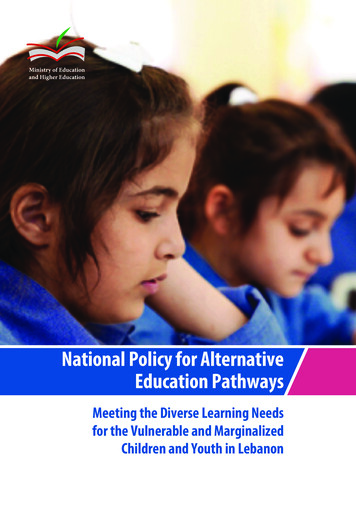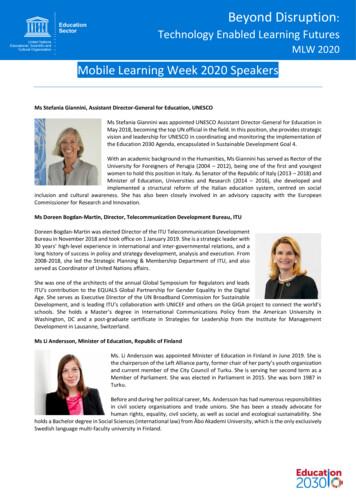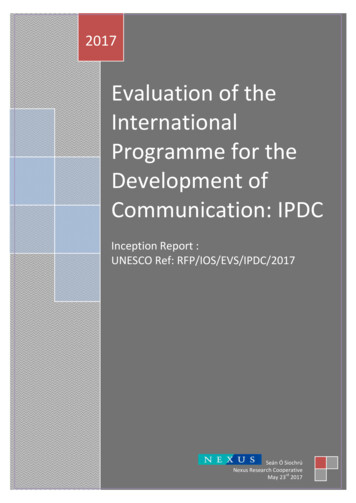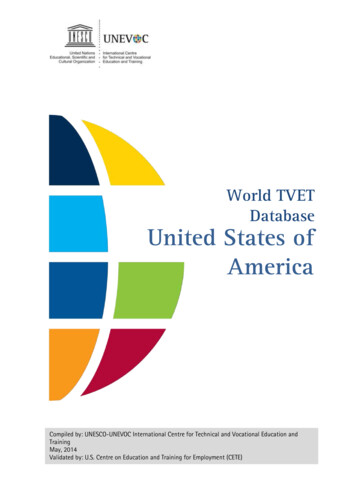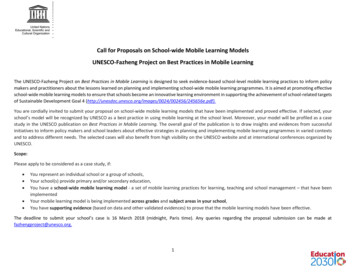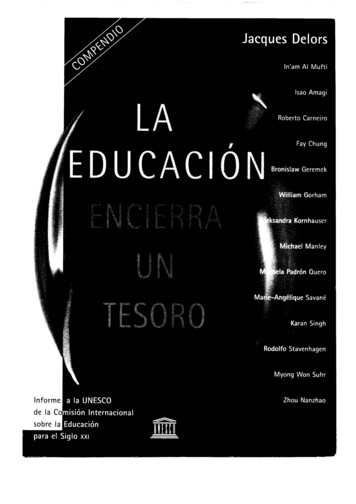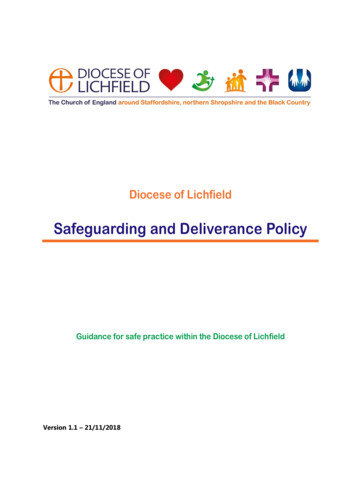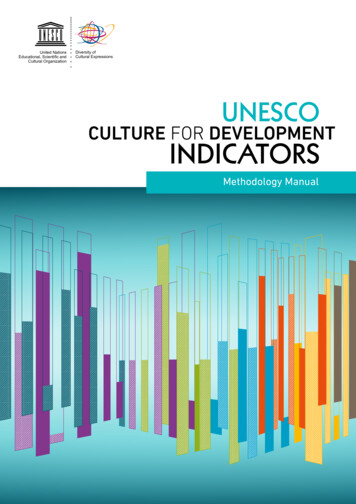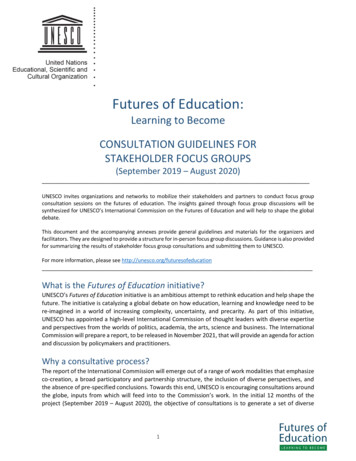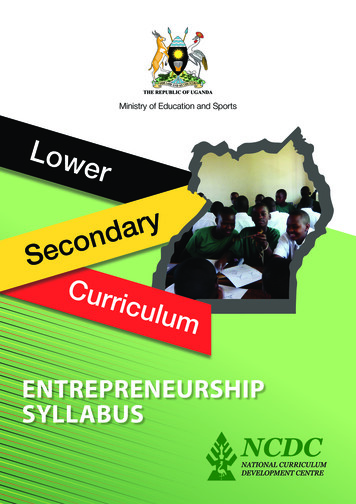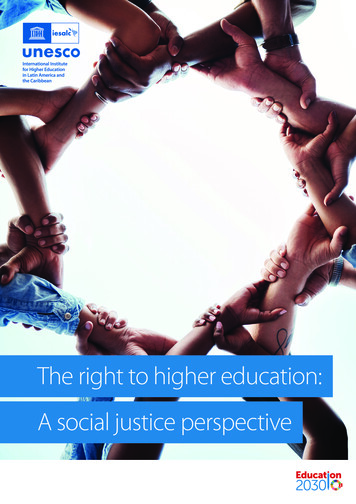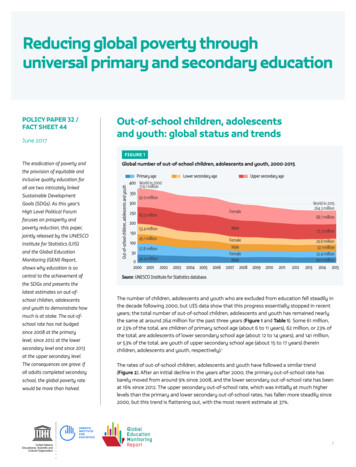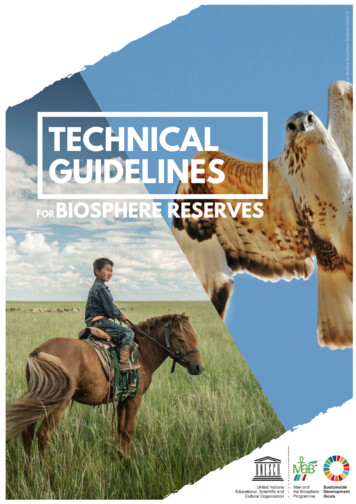
Transcription
TECHNICALGUIDELINESFORBIOSPHERE RESERVES Toson Khulstai Biosphere Reserve/UNESCO
@ UNESCO 2021The designations employed and the presentation of material throughout thisdocument do not imply the expression of any opinion whatsoever on the partof UNESCO concerning the legal status of any country, territory, city or area orof its authorities, or concerning the delimitation of its frontiers or boundaries.The ideas and opinions expressed in this publication are those of the authors;they are not necessarily those of UNESCO and do not commit theOrganisation.The Technical Guidelines are a living document, aiming to be revised to reflectthe evolution of the Man and Biosphere Programme.The Technical Guidelines for Biosphere Reserves (in English and in French)and other documents and information concerning the Man and BiosphereProgramme are available from the Programme's Secretariat :UNESCONatural Sciences SectorSecretariat of the Man and Biosphere Programme7, place de Fontenoy75352 Paris 07 SPFrancehttps://en.unesco.org/mab
ACKNOWLEDGEMENTSAt its 27th session, the International Co-ordinating Council of the Man and the Biosphere Programme (MAB-ICC)decided to develop “Technical Guidelines for Biosphere reserves" (referred as TGBR thereafter). To this end, theMAB Council established a working group (WG) of 70 experts from 33 countries nominated by Member States(the full list of members is available below) chaired by Mr Martin Price, United Kingdom, and assisted by therapporteurs Ms Catherine Cibien, France; Ms Mireille Jardin, France; Ms Beth Kaplin, Rwanda; and Ms RuidaPool-Stanvliet, South Africa. It was divided in four Thematic Subgroups (TSG): Zonation of biosphere reserve;Governance of biosphere reserves; Policy, management and business plans; and Data management andmonitoring.The TGBR is the result of work of numerous experts whose contribution is briefly described and acknowledgedbelow.Project coordination and overall guidance. The preparation of the Technical Guidelines for Biosphere reserveswas coordinated and led by Ms Noëline Raondry Rakotoarisoa from the MAB Secretariat.Writing of the TGBR: Each Thematic Subgroups drafted its related part of the TGBR. The teams of experts ofthe TSG’s worked closely together to collect the information, to analyze the issues, to select the case studies andto draft the content under the guidance of the Chairs of the TSG’ supported by the Rapporteurs.TSG Governance: Chair, Mr Martin Price, United Kingdom. Rapporteur, Ms Mireille Jardin,France. Members, Ms Mamounata Belem Ouedraogo, Burkina Faso; Ms Barbara Engels,Germany; Mr Ahua René Koffi, Ivory Coast; Mr Larry McDermott, Canada; Mr Vongani NocilusMaringa, South Africa; Mr Juan Pablo Prias, Colombia; Mr Tetsu Sato, Japan.TSG Policy Management and Business Plans: Chair Mr Lütz Moller, Germany. Rapporteur, Ms RuidaPool-Stanvliet, South Africa. Members: Mr Rodrigo Antonio Braga Moraes Victor, Brazil; Mr MikhailBrynskikh, Federation of Russia; Mr Jervis Good, Ireland; Ms Eun-Young Kim, Republic of Korea; MsGraciela Pien, Argentina; Ms Natallia Rybianets, Belarus; Ms Johanna Thomlinson, Australia.TSG Zonation: Chair Mr Reinaldo Francisco Ferreira Lourival, Brazil. Rapporteur, Ms Catherine Cibien,France. Members: Mr Benny Robert Bobowski, United States of America; Mr Doo-Soon Cho, Republicof Korea; Mr Purwanto Dea, Indonesia; Mr Ollo Theophile Dibloni, Burkina Faso; Ms Agathe Die, IvoryCoast; Ms Kah Martine Gauze Touao, Ivory Coast; Ms Zuzana Guziova, Slovakia; Mr Daouda Ngom,Senegal; Mr Johannes Pruter, Germany.TSG Data Management and Monitoring: Chair Mr Sergio Leandro, Portugal. Rapporteur Ms BethKaplin, Rwanda. Members: Mr Shadrach Olufemi Akindele, Nigeria; Mr Cristofer Gonzales Baca,Mexico; Mr Sergio Augusto Domingues, Brazil; Ms Kirsten Gallo, United States of America; Mr GabrielHirlemann, France; Mr Augustine Isichei, Nigeria; Ms Koco Marie Jeanne Kanga, Ivory Coast; Mr ZeLuo, China; Mr Adama Oueda, Burkina Faso; Ms Maria Pia Gallina Tessaro, Mexico; Ms TatyanaYashina, Federation of Russia.Information Review, compilation, and finalization of whole document : We would like to highlight the supportfrom Petr Cupà, Czeck Republic, former member of the International Advisory Committee for Biosphere reserves,for his substantive contribution to the content and for the compilation of draft texts from the TSG’s and theharmonization and finalization of the TGBR content. Petr transformed a set of draft texts and case studies into acoherent and meaningful document which laid the basis for the TGBR.
Review process: The thorough review of the TGBR project document was completed by the team of reviewerswhich was composed by members of the International Advisory committee for Biosphere reserves and the ICCMAB Bureau, who advised on drafting content and for case studies.Members of the International Advisory Committee for Biosphere Reserves: Ms Sheila NanaAkua Ashong, Ghana; Ms Vladimira Fabriciusova, Slovakia; Mr Driss Fassi, Morocco; Mr RomanJashenko, Kazakhstan; Mr Christophe Le Page, France; Mr Clayton Lino, Brazil; Ms Salwa MansourAbdel Hameed, Sudan; Ms Graciela Pien, Argentina; Ms Lia Rosenberg, Estonia; Ms Suk-KyungShim, Republic of Korea; Ms Marja Spierenburg, The Netherlands; Mr Djafarou Tiomoko, Benin.Members of the ICC MAB Bureau: Chair: Ms Enny Sudarmonowati, Indonesia. Vice-chairs: Mr AdepojuOlatunde Adeshola, Nigeria; Mr Toomas Kokovkin, Estonia; Ms Johanna MacTaggart, Sweden; Mr CarlosMadariaga, Honduras; Ms Salwa Mansour Abdel Hameed, Sudan.Special thanks to Mr Martin Price for the editing of the English version, to Ms Charlotte Bouyat, intern secondedby the French MAB Committee to the MAB Secretariat and M. Ibrahim Ghouonzengnigni, intern, who help ingathering information, documentation and logistical support to the online meeting of the TSGs and to Ms SandrineBaron and Amandine Callens from MAB Secretariat for administrative support, translation and layout of theTGBR.List of the 70 experts members of the working group on the Technical Guidelines for Biosphere ReservesAs part of the Governance working group: Ms Mamounata Belem Ouedraogo, Burkina Faso; Mr PavloCherinko, Ukraine; Ms Vladimira Fabriciusova, Slovakia; Ms Barbara Engels, Germany; Ms Crisina Irimia;Romania; Ms Mireille Jardin, France; Mr Ahua René Koffi, Ivory Coast; Mr Lazaro Marquez Llauger, Cuba;Mr Larry McDermott, Canada; Mr Vongani Nocilus Maringa, South Africa; Mr Syed Mahmood Nasir,Pakistan; Mr Juan Pablo Prias, Colombia; Mr Martin Price, United Kingdom; Mr Joao Lucilio Ruegger deAlbuquerque, Brazil; Mr Sergio Guevara Sada, Mexico; Mr Tetsu Sato, Japan; Mr Wekesa BonifaceWanyama, Kenya.As part of the Policy Management and Business Plans working group: Mr Frédéric Bioret, France;Mr Rodrigo Antonio Braga Moraes Victor, Brazil; Mr Mikhail Brynskikh, Federation of Russia; Mr DrissFassi, Morocco; Ms Maritza Garcia, Cuba; Mr Jervis Good, Ireland; Mr Lamoussa Hebie, Burkina Faso;Ms Eun-Young Kim, Republic of Korea; Ms N'dri Marie-Thérèse Kouame, Ivory Coast; Mr Jean PhilippeMessier, Canada; Mr Lütz Moller, Germany; Mr Antoine Njiang, Cameroon; Mr Donat Nsabimana,Rwanda; Ms Graciela Pien, Argentina; Ms Ruida Pool-Stanvliet, South Africa; Ms Natallia Rybianets,Belarus; Mr Avelino Suarez Rodriguez, Cuba; Mr Carlos Mario Tamayo Saldarriaga, Colombia; MsJohanna Thomlinson, Australia; Mr Kentaro Yoshida, Japan.As part of the Zonation working group: Mr Zoran Acimov, Romania; Mr Benny Robert Bobowski, UnitedStates of America; Mr Doo-Soon Cho, Republic of Korea; Mr Purwanto Dea, Indonesia; Mr Nouhou Diaby,Senegal; Mr Ollo Theophile Dibloni, Burkina Faso; Ms Agathe Die, Ivory Coast; Mr Reinaldo FranciscoFerreira Lourival, Brazil; Mr Fidel Hernandez Figueroa, Cuba; Ms Kah Martine Gauze Touao, Ivory Coast;Ms Zuzana Guziova, Slovakia; Mr Daouda Ngom, Senegal; Mr Abgoola Okedeji Okeyoyin, Nigeria; MsRubiela Pena Velasco, Colombia; Mr Johannes Pruter, Germany; Mr Samuel Christian Tsakem,Cameroon.As part of the Data Management and Monitoring working group: Mr Shadrach Olufemi Akindele,Nigeria; Mr Jaro Arero, Kenya; Mr Cristofer Gonzales Baca, Mexico; Mr Sergio Augusto Domingues,Brazil; Ms Kirsten Gallo, United States of America; Mr Salah Hakim, Sudan; Mr Gabriel Hirlemann,France; Mr Augustine Isichei, Nigeria; Ms Koco Marie Jeanne Kanga, Ivory Coast; Ms Beth Kaplin,Rwanda; Mr Sergio Leandro, Portugal; Mr Ze Luo, China; Mr Adama Oueda, Burkina Faso; Ms JenniRoche, Ireland; Ms Maria Pia Gallina Tessaro, Mexico; Ms Tatyana Yashina, Federation of Russia.
Acronyms and abbreviationsAfriMABSub-Saharan Africa MAB NetworkArabMABArab States MAB NetworkASPnetUNESCO Associated Schools NetworkBRBiosphere ReserveCaeMABContinental Aquatic Ecosystems MAB NetworkCAREComplementarity, Adequacy, Representation and EfficiencyCASChinese Academy of SciencesCBMSwedish Biodiversity CentreCBRACanadian Biosphere Reserve AssociationCITESConvention on International Trade in Endangered Species of Wild Faunaand FloraCREMACommunity Resource ManagementCUECommission for University EducationEABRNEast Asian Biosphere Reserve NetworkEAPEast-Asia-PacificEMANEcological Monitoring and Assessment NetworkEOLSSEncyclopedia of Life Support SystemsEPAEnvironment Protection AuthorityERAIFTRegional Post-graduate Training School on Integrated Management ofTropical Forests and LandsESDEducation for Sustainable DevelopmentEUEuropean UnionEuroMABEurope and North America MAB NetworkGAGreat ApesGCBRGouritz Cluster Biosphere ReserveGCEDGlobal Citizenship EducationGEBRGreen Economy in Biosphere ReservesGEFGlobal Environment FacilityGISGeographic Information SystemGIZGerman Company for International CooperationGLOCHAMOREGlobal Change in Mountain RegionsGPSGlobal Positioning SystemHISTInternational Centre on Space Technologies for Natural and CulturalHeritagesHNPTHustai National Park TrustIACBRInternational Advisory Committee for Biosphere ReservesIBRMIntercontinental Biosphere Reserve of the MediterraneanICCARInternational Coalition of Inclusive and Sustainable CitiesICLInternational Consortium on LandslidesIHPIntergovernmental Hydrological Programme
ILTERInternational Long-term Ecological Research NetworkIMFNInternational Model Forest NetworkINFOCOOPInstitute for Cooperative DevelopmentIRCKInternational Research Centre on KarstITInformation TechnologyIUCNInternational Union for Conservation of NatureKGUNKenya Green University NetworkKOICAKorea International Cooperation AgencyKUKyoto UniversityLMBRLower Morava Biosphere ReserveLTERLong-term Ecological ResearchLTSERLong-term Socio-Ecological ResearchMABMan and the BiosphereMAB-ICCInternational Coordinating Council for the MAB ProgrammeMABRMata Atlântica Biosphere ReserveMABRMount Arrowsmith Biosphere RegionMABRRIMount Arrowsmith Biosphere Region Research InstituteMARXANMarine Spatially Explicit AnnealingMIDAMulti-Internationally Designated AreaNEMANational Environment Management AuthorityNGONon-Governmental organizationNordMABNordic countries MAB NetworkODAOfficial Development AssistanceOUVOutstanding Universal ValuePAProtected AreaPacMABPacific Biosphere Reserve NetworkRAMSARConvention on Wetlands of International Importance, especially asWaterfowl HabitatREDBIOSEast Atlantic Biosphere Reserve NetworkRISRamsar Information SheetsRSCNRoyal Society for the Conservation of NatureSACAMSouth and Central Asia MAB NetworkSBRShouf Biosphere ReserveSDSustainable DevelopmentSeaBRnetSoutheast Asian Biosphere Reserve NetworkSDGsSustainable Development GoalsSUMAMADSustainable Management of Marginal Drylands ProjectTBRTransboundary Biosphere ReserveTGBRITechnical guidelines for Biosphere ReservesTGBR-WGTGBR-working group
TSG’sThematic SubgroupsTVETTechnical and Vocational Education and TrainingUNDPUnited Nations Development ProgrammeUNEPUnited Nations Environment ProgrammeUNITWINUniversity Twinning and Networking ProgrammeVIUVancouver Island UniversityWHSWorld Heritage SiteWNBRWorld Network of Biosphere ReservesWWAPWorld Water Assessment ProgrammeWWDRWorld Water Development ReportZIISInstitute of Earthquake Engineering and Engineering Seismology
Table of ContentsIntroduction1. Nomination, revision and review of a biosphere reserve1.1. Considerations preceding the nomination1.2 Biosphere reserves as learning sites for sustainable development: three integrated functions (Article 3Statutory Framework)1.3. How to nominate a biosphere reserve1.4. How to initiate a nomination1.5. How to prepare a nomination file1.6. What is the Designation Procedure? (Article 5, Statutory Framework)1.7. How to nominate transboundary biosphere reserves1.8. What are multi-designated sites?1.9. How to extend an existing biosphere reserve1.10. How to rename a biosphere reserve1.11. Review of a biosphere reserve1.12. How to voluntarily withdraw a biosphere reserve2. Size and zonation2.1. Size2.1.1. How to determine if a biosphere reserve has the appropriate size to serve the three functions(Statutory Framework, Article 4, paragraph 4)2.2. Zonation (Statutory Framework, Article 4, paragraph 5)2.2.1. What components are required in the zonation of a biosphere reserve2.2.1.1. Core area: legally constituted core area(s) devoted to long-term protection2.2.1.2. Buffer zone: clearly identified zone(s) surrounding or contiguous to the core area(s),geographical definition2.2.1.3. Transition area: an outer transition area where sustainable resource management practicesare promoted and developed, geographical definition2.3.2.4.2.5.2.6.Transboundary biosphere reservesMulti-designated sitesCluster type biosphere reservesSpecial case: overlapping biosphere reserves3. Governance3.1 Governance structure3.1.1. Why is a governance structure necessary for biosphere reserves3.1.2. What is a governance structure and how does it work3.1.3. How to plan and implement a governance structure for biosphere reserves3.2. Participatory planning3.2.1. Public authority3.2.2. Local communities3.2.3. Traditional authorities3.2.4. Civil society3.2.5. Private sector3.2.6. Scientific community3.3. Transboundary biosphere reserves3.4. Multi-designated sites3.5. The role and structure of National MAB Committees
4. Plans, policies and strategies for biosphere reserves4.1. Management plan4.1.1. Why is a management plan necessary (i.e. what are its crucial benefits)4.1.2. What should a management plan include4.1.3. Issues to be addressed by a management plan4.1.4. How to plan and draft a management plan4.1.5. How to implement a management plan4.2. Policies and legislation4.3. Business plan4.3.1. Why is a business plan necessary4.3.2. How to plan a business plan4.3.3. How to start writinga business plan4.3.4. How is a business plan structured4.3.5. Funding models for biosphere reserves4.4. Marketing strategy4.4.1. Why is a marketing strategy sensible or even necessary4.4.2. What is a marketing strategy and what should it include4.4.3. How to develop a brand for biosphere reserves4.4.4. Communication plan4.4.4.1.Why is a communication strategy and plan necessary4.4.4.2.What is a communication plan and what should it include4.4.4.3.How to draft and implement a communication plan4.5. Transboundary biosphere reserves4.6. Multi-designated sites5. Monitoring and evaluation in biosphere reserves5.1. What data should biosphere reserves monitor5.2. Quality control5.2.1. How to track performance of a biosphere reserve5.2.2. What tools can you use to monitor biosphere reserves5.2.2.1.Systematic zoning and biosphere reserves5.3. What does a functioning model of a biosphere reserve look like5.4. Periodic review5.4.1. What is the Process of Excellence5.4.2. How to prepare a report for the periodic review5.5. Web-based information clearing house and information centre5.6. Transboundary biosphere reserves5.7. Multi-designated sites6. Networks and partnerships to support biosphere reserves6.1.6.2.6.3.6.4.6.5.6.6.6.7.Scientific researchEducation and trainingNational biosphere reserve networksTwinning of biosphere reservesRegional and thematic networksOther relevant networks of UNESCO including UNESCO designationsOther networks and initiatives
Background and purpose of the Technical Guidelinesfor Biosphere Reserves (TGBR)1.Biosphere reserves worldwide operate according to the StatutoryFramework of the World Network of Biosphere Reserves (WNBR). This keydocument embraces the philosophy of the Man and the Biosphere (MAB)Programme and the concept of biosphere reserves. One of its indisputableassets is its flexibility which allows the biosphere concept to be appliedworldwide in a broad variety of contexts.2. Since the adoption of the Statutory Framework in 1995, the WNBR hascontinued to grow. As the network expands, new challenges emerge givingrise to new technical and practical questions. At the same time, many globalinstitutions are facing increasing pressures to showcase quality management.To address these challenges, in 2017 the International Coordinating Councilof the MAB Programme (MAB-ICC) introduced the ‘Process of excellence andenhancement of the WNBR as well as quality improvement of all members ofthe World Network’.3. Many newly proposed sites, as well as existing biosphere reserves duringthe periodic review process, have confronted issues that could not be clearlyresolved by the Statutory Framework. These matters usually relate tofunctions (Article 3), criteria (Article 4), the nomination of new biospherereserves (Article 5), periodic review reports (Article 9), and the management ofbiosphere reserves already part of the WNBR and its regional and thematicsubnetworks (Article 8). Furthermore, implementation of the current MABStrategy (2015-2025) and the Lima Action Plan (2016-2025) requires detailedguidelines beyond those available in the Statutory Framework. This is also thecase for future all Strategies and Action Plans.4. In order to provide additional support to all WNBR stakeholders (or actors),the MAB-ICC at its 27th session (2017) decided to develop a set of TechnicalGuidelines for Biosphere Reserves (hereafter referred to as TGBR). TheTGBR should enable Member States and other MAB stakeholders to addressthe various practical challenges and technical questions encountered in theimplementation of articles of the Statutory Framework, based on cutting-edgescientific knowledge, state-of-the-art practical expertise and politicalconsensus.5. The MAB-ICC approved the format of the Technical Guidelines at its 29thsession. The TGBR is an open access, web-based, living document compilingcontributions and experiences from the MAB community on specific items,including the nomination, revision and review of a biosphere reserve, and thefollowing priority areas: size and zonation; governance; plans, policies andstrategies for biosphere reserves; monitoring and evaluation in biospherereserves; and networks and partnerships to support biosphere reserves. Overtime, the TGBR will expand to include additional themes for which guidance isrequired (e.g. local economic activities, templates with regard to reporting,collaboration with the private sector, participation, etc.) The MAB-ICC agreedto establish thematic working groups, and their contributions constitute thebasis of this document. A significant amount of valuable information was alsodrawn from the Management Manual for UNESCO Biosphere Reserves inAfrica (2015); the preparation of which was supported by the GermanCommission for UNESCO. Miura Drava Danube Transboundary Biosphere Reserv, Austria, INTRODUCTION
6. The purpose of the TGBR is to support the implementation of the articles of the Statutory Framework andsubsequent Strategies and Action Plans. It is based on the practical experience of the MAB Programme. As theTGBR cannot respond to all possible questions and needs, its design is purposefully flexible and will beperiodically updated. It is also designed to be used in conjunction with the TGBR support webpage, where topicscan be shared and discussed in greater detail.7. The primary target group of this document is stakeholders1 of existing and prospective biosphere reserves.The term ‘stakeholder’ is used in this document for reasons of simplicity,as the individuals and groups concerned1with, and with a stake in, biosphere reserves (thereafter referred to as BR) are as diverse as the BR themselves.They include all right holders at all levels of society and may have various levels of affiliation to the MABProgramme. It would be impossible to explicitly name all relevant groups here, but they encompass landowners,land users, Indigenous peoples and local communities, civil society organizations, National MAB Committees,biosphere reserve managers, governmental authorities at all levels, private companies, and intergovernmentaland international organizations.The term stakeholders typically refers to both rights holders (an array of rights and an array of holders of suchrights), as well as certain interested parties who should be taken into consideration to varying degrees whenconsidering governance and decision-making.1
Fogo Biosphere Reserve, Cabo VerdeNOMINATION, REVISION,AND REVIEW OF ABIOSPHERE RESERVE
8. It is important to consider several points before deciding whether to prepare a proposal for anew biosphere reserve. These considerations are linked to specificities of the MAB Programmeand its biosphere reserves and help to determine whether to start the process.1.1. Considerations preceding the nominationa) Local support and vision9. A biosphere reserve is a tool to advance the well-being of human beings and nature; it is notmerely a title or a synonym for nature conservation. A biosphere reserve should benefit peopleas well as the environment. Local communities and other key actors should therefore have aclear understanding of why they want to create a biosphere reserve, how they will utilize thebiosphere reserve concept in their everyday lives, how they will benefit, and how they willeventually contribute to the goals of the MAB Programme and UNESCO. Local communitiesespecially should have a say in the process, notably regarding the choice to designate theirarea a reserve and what they aim to achieve once the site has been designated. The term‘local communities’ refers not only to stakeholders such as farmers’ representatives, localpoliticians, chiefs and so on – it includes everybody living and working in the territory.Biosphere reserves are sometimes created through a top-down process, but bottom-upprocesses are preferred. In some cases, a combination of top-down and bottom-upapproaches is needed to secure buy-in from a wide range of institutions, as well as to createopportunities for sustainability innovation in terms of governance. Crucially, all stakeholdersshould participate collaboratively in drafting, approving and supporting the vision for thebiosphere reserve.b) Location10. Biosphere reserves are areas subject to special recognition and (at least partially) someform(s) of legal protection. However, areas strictly devoted to conservation objectives within abiosphere reserve should not dominate the territory, as the goals, activities and mission ofbiosphere reserves differ and extend beyond those of regular protected areas (e.g. IUCNCategories I to IV). The area and location need to allow for the implementation of all threefunctions of biosphere reserves (see below, under Activities). Having a biosphere reserve thatis (considerably) larger than the protected areas – and which includes places where peoplelive, sometimes in urban centres – will also avoid confusion among various protection statusesand the biosphere reserve.11. A biosphere reserve must be ‘representative of their biogeographic region and of significancefor biodiversity’. Representativity does not necessarily imply that the natural or culturallandscape of the region has an ‘outstanding universal value’, as defined under the WorldHeritage Convention. The criterion of representativity aims to avoid biosphere reserves thatare too similar, and in turn, to ensure that the WNBR represents all biogeographic regions ofthe world. Still, biosphere reserves need to be important or “significant” sites, based on theirbiodiversity value – such value must be present at least in the core area(s). Therefore, bothrepresentativity and biodiversity significance are starting points for the work of a biospherereserve: key factors in the decision as to whether it can be designated by UNESCO. It is13
possible that, when the core area includes significant biodiversity, the landscapes of the otherzones are “ordinary” – yet they will be a focus of the work of the biosphere reserve in order tomake a positive difference, focusing on specific on-site challenges and their solutions in asustainable and participative manner, and becoming a learning site for sustainabledevelopment and a model for other places, with great impact potential.c) Governance12. The biosphere reserve governance structure should be effective, efficient and, whereverpossible, flexible, democratic and inclusive of the various stakeholders (communities,entrepreneurs, governmental authorities, non-governmental organizations (NGOs),universities, schools, etc.). The structure should, furthermore, guarantee their involvement indecision-making processes, and an equal position in management and even distribution ofgovernance powers across the biosphere reserve. If conditions allow, all biosphere reservegovernance participants should be equal in their voice, regardless of their position in thesociety.d) Funding13. Any biosphere reserve needs funding in order to effectively implement sustainabledevelopment. The financial sources in question should be diverse to the extent possible,ensure a reliable core budget over the long term, and be identified prior to the nominationprocess. As well as safeguarding the future of the biosphere reserve, long-term core fundingshould guarantee the salary of full-time professionals and provide adequate means for criticalmeetings, especially those involving stakeholders. Projects as well as core funding can befunded, at least in part, through a mix of support from participating stakeholders, tourism levies,marketing, international and local partners, governmental support – as mentioned in the LimaAction Plan (e.g. Goal A5, Action A5.3) – and international sources (e.g. EU funding, bilateralaid, etc.)e) Activities14. Biosphere reserves focus on balancing nature conservation with sustainable development forand with communities. They must fulfil three basic, equal and mutually complementaryfunctions: Conservation, Development and Logistical Support.15. Biosphere reserve management should address stakeholder needs while fulfilling all threebasic functions. Such management needs to be laid down in a management plan or policy withrelevant activities. It is not necessary to include a full-scale management plan with thenomination dossier for submission to the MAB Secretariat. However, a sufficiently advanceddraft management plan or policy should be available, indicating the objectives and maindefined lines of action, and the vision and mission of the site.14
1.2. Biosphere reserves as learning sites for sustainable development: three integratedfunctions (Article 3, Statutory Framework)16. All biosphere reserves must fulfil three basic, equal and mutually complementary functions:(1) Conservation – conservation of natural and bio-cultural diversity(2) Development – support for sustainable economic and social development and culturaldiversity(3) Logistic support – support and promotion of model projects, training and education forsustainable development, research and monitoring linked to nature conservation andsustainable development at the local level, while taking into account national and global scales.17. All three biosphere reserve functions must be integrated and balanced. Favouring some of thefunctions at the expense of others will compromise the success of the nomination process orthe periodic review (a decennial quality control measure), and also usually leads to significantlyreduced performance and subsequent unequal impact of biosphere reserve activities. Forexample, a sole focus on biodiversity conservation will undermine the added value of the MABProgramme and the biosphere reserve designation to the detriment of local communities andthe planet at large.18. It is vital to maintain a broad understanding of the three functions and to exercise flexibility inplanned actions. In terms of conservation, it is also important to focus on bio-cultural diversityas well as biodiversity. Support for sustainable development is the main significant distinctionbetween biosphere reserves and other designations or types of protected area. Similarly,logistic support plays a specific role in the integration of the three functions, grounding andunderpinning the conservation and development functions. As far as possible, all biospherereserve activities should be based on carefully adapted, high-quality scientific evidence. If thescience is complemented by local or traditional knowledge, or vice versa, the outcomesbecome more feasible. The utilization of local knowledge is also mentioned in the Lima ActionPlan (e.g. Goal B.7). In terms of logistical functions, most biosphere reserves do not possessscientific teams, instead collaborating with various institutions on research and other activitiessuch as education, training and communication. Monitoring also plays a vital role in fulfillingthis function, as the knowledge gained through the process constitutes the basis forassessment of the state of the biosphere reserve (important also for Periodic Reviewing) andsound management decision-making. Furthermore, sharing the data improves the impact ofbiosphere reserves on a larger scale.1.3. How to nominate a biosphere reserve19. The nomination procedure for a biosphere reserve process may start as a bottom-up or
The Technical Guidelines are a living document, aiming to be revised to reflect the evolution of the Man and Biosphere Programme. The Technical Guidelines for Biosphere Reserves (in English and in French) and other documents and information concerning the Man and Biosphere Programme are available from the Programme's Secretariat :
